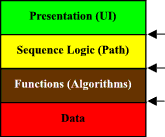
Scale
Diversity
Complexity
Using modern technology the presentation layer is invariably devolved to the users desktop1. If all four layers are devolved, no common data exists and for IT purposes the business units are effectively
independent2 Within a single business unit there are three potential positions at which the devolved – common boundary can be placed
.
Scale organisations control process closely from the centre. This leads to highly centralised systems and is consistent with mainframe style or thin client/ web browser technologies where only the user interface and the presentation layer actually execute at the users workstation.
Complexity based organisations typically devolve technology to individual specialised units, each of which has distinctive IT to support its specific functional needs. These organisations usually require the specialist units to share common data in order to achieve the overall goal. This approach favours an IT devolution boundary that lies between the application functions and the data, and encourages distributed workgroup style computing and networked database technologies.
Information Systems in diversified organisations provide customer-facing staff with independence and autonomy in the way they work – in order for them to offer the customer specific services that form the basis of the organisations market positioning. However the need to ensure consistency to achieve efficiency, equity across customers and compliance to standards leads to a separation between the sequence in which work is done, which is devolved, and the way in which specific functions are executed, which is centrally defined. This approach is best supported by the provision of IT based tools (personal productivity) and favours the deployment of thick clients and network/web-based services.
If we consider an information system as four logical layers, we can separate the data from the application logic and the user interface. The application logic can be considered as two separate components. One being the sequence logic which
defines the order in which activities are performed; the other being the algorithms that define the specifics of a particular activity.
Different organisations will choose to devolve these components in different ways.
1This includes not only standard PC’s but also PoS terminals and other specialised user workstations.
2This consideration only applies to application programs and associated data. Organisations frequently share networks,
infrastructure and/or supporting services without necessarily sharing applications or operational data.
Each organisation model adopts a different approach to the Information systems it implements, and the support services required to allow users to do their jobs effectively.
